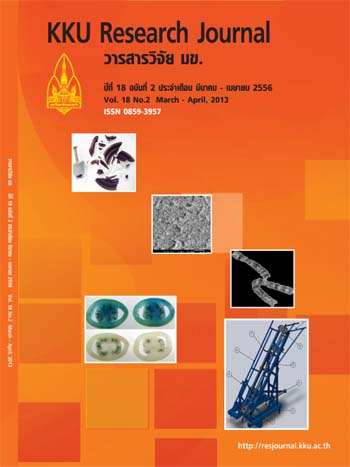Production and detection of - glucuronidase (GUS) protein in fruit tissue of papaya (Carica papaya L.) and banana (Musa acuminata L.) using Agrobacterium transient transformation
Main Article Content
Abstract
Heterologous protein production and determination of fruit specific promoter require gene transformation into target plant host. Fruits transformed gene by Agrobacterium is the convenient and rapid method. The outcome is clearly revealed by producing heterologous and functional protein. In this study, two fruit plant species for heterologous protein production, banana and papaya were transiently transformed with In this study, two fruit plants; banana ((Musa acuminata L.) and papaya (Carica papaya L.) were determined the GUS gene expression and heterologous protein production after transiettly transformation with Agrobacterium tumefaciens AGL-1 containing a plant expression vector, pCAMBIA1304 with  -glucuronidase (GUS) gene as a reporter gene during mature fruit and color break fruit . Factors influencing transformation efficiency including fruit developmental stages, bacterial concentration and incubation time were investigated. The transformation efficiency was determined by GUS staining and GUS enzymatic activity. The results showed that bacterial dilution at 1:10 for 30 min, was exhibited the most effective results in both fruit. This method was also applicable to tomato, a fruit model commonly used for gene expression, promoter and protein production.
-glucuronidase (GUS) gene as a reporter gene during mature fruit and color break fruit . Factors influencing transformation efficiency including fruit developmental stages, bacterial concentration and incubation time were investigated. The transformation efficiency was determined by GUS staining and GUS enzymatic activity. The results showed that bacterial dilution at 1:10 for 30 min, was exhibited the most effective results in both fruit. This method was also applicable to tomato, a fruit model commonly used for gene expression, promoter and protein production.
 -glucuronidase (GUS) gene as a reporter gene during mature fruit and color break fruit . Factors influencing transformation efficiency including fruit developmental stages, bacterial concentration and incubation time were investigated. The transformation efficiency was determined by GUS staining and GUS enzymatic activity. The results showed that bacterial dilution at 1:10 for 30 min, was exhibited the most effective results in both fruit. This method was also applicable to tomato, a fruit model commonly used for gene expression, promoter and protein production.
-glucuronidase (GUS) gene as a reporter gene during mature fruit and color break fruit . Factors influencing transformation efficiency including fruit developmental stages, bacterial concentration and incubation time were investigated. The transformation efficiency was determined by GUS staining and GUS enzymatic activity. The results showed that bacterial dilution at 1:10 for 30 min, was exhibited the most effective results in both fruit. This method was also applicable to tomato, a fruit model commonly used for gene expression, promoter and protein production.
Article Details
How to Cite
Nacharoen, S., Koohapitakthum, R., Bhunchoth, A., Warin, N., & Burns, P. (2017). Production and detection of - glucuronidase (GUS) protein in fruit tissue of papaya (Carica papaya L.) and banana (Musa acuminata L.) using Agrobacterium transient transformation. Asia-Pacific Journal of Science and Technology, 18(2), 289–296. retrieved from https://so01.tci-thaijo.org/index.php/APST/article/view/82848
Section
Research Articles


